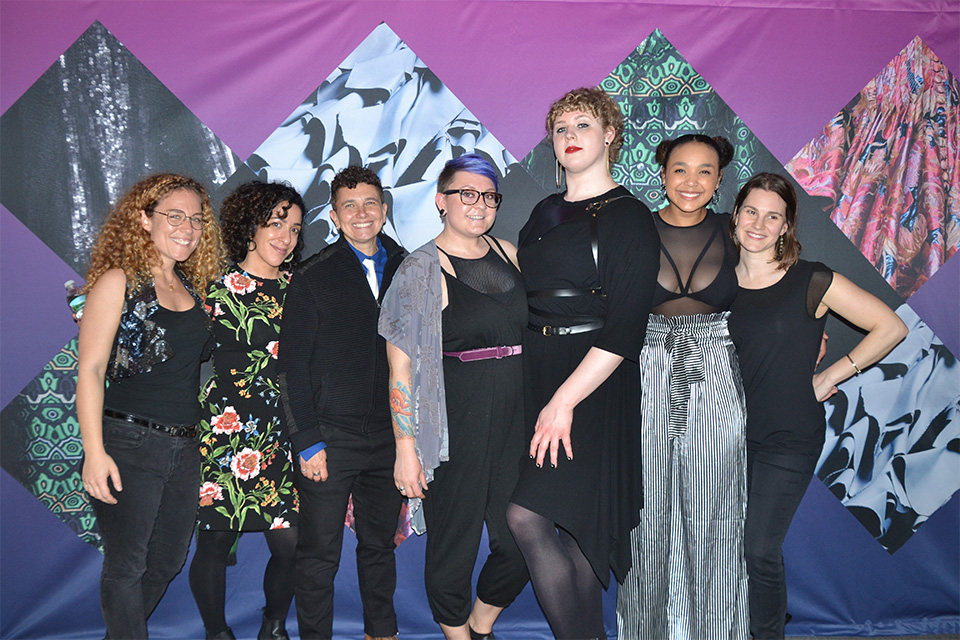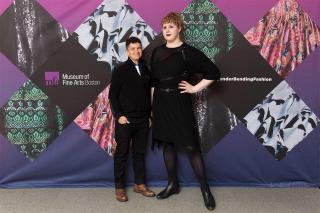The Museum of Fine Arts's Gender Bending Fashion exhibit is about more than just the items of clothing that we wear. This first of its kind exhibit highlights the ways in which fashion has historically served as a vehicle for self-expression, and how fashion continues to evolve as a reflection of identity. Gender and Cultural studies student, Matisse DuPont '19MA and Professor Jo Trigilio both served as consultants on the interpretation team. We asked them to tell us more about the exhibit and their involvement with its development.
What does it mean for you to be involved in this project?
Matisse DuPont: Consulting on this show was an affirmation that studying gender and cultural studies was the right decision for me. Being able to apply my knowledge as an academically informed member of the LGBTQIA+ community to this widely reviewed exhibition at such a prestigious institution was incredibly fulfilling.
At the MFA Late Nite opening there were upwards of 5,000 people all there to see the show and read the texts I had helped craft — the queer energy in that space was palpable and invigorating. Knowing that I helped make the museum more accessible for my community makes me glow with pride. I ensured that the interpretive texts were in line with contemporary theories of gender and sexuality, while still remaining accessible and edifying for the public, and I successfully advocated for the museum to open its first permanent, multi-stall, all-gender restrooms.
Professor Trigilio: Being involved in this project is absolutely thrilling for someone like me. In addition to teaching LGBT Studies, Queer, Race, and Gender theories as a professor, I have been immersed in LGBTQ culture and have worked as an LGBT activist since I was 18 years old. This was the perfect opportunity to combine the academic, cultural, and activist aspects of my life. As someone who is gender variant, having the MFA affirm the creativity and artistry of gender bending fashion is exciting enough. Having the opportunity to participate in the development of this project is an honor.
Matisse, did any of your work in the gender and cultural studies program inform your process or your contributions?
Matisse: Certainly! The theoretical lenses my professors have taught us guided my decisions as a consultant. As I helped craft the interpretive texts with Adam Tessier, Head of Interpretation, and Michelle Finamore, Penny Vinik Curator of Fashion Arts, I used my understandings of the multiplicative, intersectional oppressions the individuals at the center of the show experienced and as well as an awareness of culturally and historically contingent identity to ensure the texts were as accurate and comprehensive as possible.
Professor Trigilio, you helped to compile a glossary of terms to accompany the exhibit. Why was that important?
Professor Trigilio: I applaud the MFA for taking the time to provide an educational context for the exhibit. Gender variance is poorly understood and often conflated with sexual orientation. The glossary provides definitions of terms associated with gender variance and sexual orientation. The glossary, along with text, create an educational opportunity for the multitude of visitors who pass through the MFA every day, many of whom would not be exposed this information otherwise.

Designer Christian Siriano recently received accolades for championing inclusivity with the tuxedo gown Billy Porter debuted at the Oscars. Are you hopeful about the future of fashion for all?
Matisse: I’d like to be optimistic about the future of post-gender fashion! It would be swell to see more people blending and breaking all the gendered sartorial rules. For queer people, this is already a reality. However, the overwhelming hegemony and dogma of white, cisgender, heterosexual patriarchy still reigns supreme, so I can’t image this utopian world of free-form expression and presentation emerging quite yet in mainstream culture. The high-fashion world has been playing with gender-bending this whole time, but the garments from that realm are slow and sporadic in trickling down into the clothing most people have access to. I’m cautiously hopeful.
Professor Trigilio: I agree with Mati. The worlds of celebrities, the wealthy, and high fashion have always included elements of gender bending fashion. With respect to the mainstream, gender bending fashion trends are cyclical. We move toward androgyny, then back toward binary gender. In the end, our lived gender roles, not the world of fashion, will dictate whether we will move toward gender fluid or androgynous attire. The more irrelevant our gender becomes to the jobs we have, the tasks we undertake, etc., the more we will move toward having our fashion choices liberated from the constraints of gender norms.
What are you working on next?
Matisse & Professor Trigilio: We're both working on the Boston Pride 2019 Communications Team. We're very committed to working at the intersection of theory and practice.

